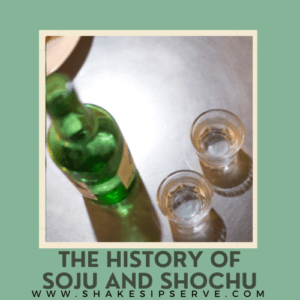Soju: Korea’s National Drink
Soju traces its origins to Korea, where it was first distilled during the Mongol invasions of the 13th century. The Mongols brought with them traditional distillation methods from the Middle East, which Koreans adapted to create soju. Over time, soju became an integral part of Korean culture, enjoyed in rituals, celebrations, and everyday gatherings.
Shochu: Japan’s Beloved Elixir
In Japan, shochu has a similarly storied past, with evidence of distillation dating back to the 16th century. Originally crafted from rice, shochu production expanded to include other grains such as barley, sweet potatoes, and buckwheat, each contributing unique flavors and aromas to the final spirit. Shochu’s versatility and adaptability made it a staple in Japanese cuisine and social life, enjoyed in a variety of settings and occasions.
Production Process and Ingredients
Despite their shared classification as distilled spirits, soju and shochu differ significantly in terms of ingredients, production methods, and flavor profiles.
Soju: Clean and Smooth
Soju is typically made from grains such as rice, barley, or wheat, although modern variations may incorporate ingredients like sweet potatoes or tapioca. The fermentation and distillation process for soju results in a clean, neutral spirit with a subtle sweetness and smooth finish.
Key Ingredients:
- Rice, Barley, Wheat: Traditional bases for fermentation.
- Sweet Potatoes, Tapioca: Modern additions for flavor variation.
Production Process:
- Polishing the Grains: Similar to sake, the grains are polished to remove outer layers.
- Fermentation: The grains are fermented using yeast and koji mold.
- Distillation: The fermented mash is distilled to produce a clear, potent spirit.
- Dilution: The distilled spirit is often diluted with water to lower the alcohol content, making it more palatable.
Shochu: Diverse and Robust
Shochu can be crafted from a wider range of raw materials, including barley, sweet potatoes, rice, buckwheat, and even sugar cane. Each ingredient imparts distinct characteristics to the final product, with barley shochu known for its earthy and nutty notes, sweet potato shochu for its rich and savory profile, and rice shochu for its delicate and floral aroma.
Key Ingredients:
- Barley (Mugi): Earthy and nutty.
- Sweet Potatoes (Imo): Rich and savory.
- Rice (Kome): Delicate and floral.
- Buckwheat (Soba): Unique and hearty.
- Sugar Cane (Kokuto): Sweet and aromatic.
Production Process:
- Preparation: The base ingredient is prepared (steamed, mashed, etc.).
- Fermentation: The prepared ingredient is fermented using koji mold and yeast.
- First Distillation: The initial fermentation mash is distilled.
- Secondary Fermentation: The distillate is fermented again for added complexity.
- Second Distillation: The secondary mash is distilled to refine the spirit.
Varieties and Flavor Profiles
Both soju and shochu offer a diverse array of styles and flavors, ranging from clear and crisp to rich and complex.
Soju Varieties
- Traditional Soju: Distilled to a higher proof and diluted with water to achieve a lower alcohol content. It maintains a clean, smooth character with subtle sweetness.
- Modern Soju: Undergoes multiple distillations to create a smoother and more refined spirit. It often features added flavors such as fruit or herbs.
Shochu Varieties
- Barley Shochu (Mugi): Offers earthy and nutty flavors, often enjoyed neat or on the rocks.
- Sweet Potato Shochu (Imo): Known for its rich and savory profile, ideal for pairing with hearty dishes.
- Rice Shochu (Kome): Delicate and floral, often appreciated for its subtle elegance.
- Buckwheat Shochu (Soba): Unique and hearty, offering a robust flavor profile.
- Sugar Cane Shochu (Kokuto): Sweet and aromatic, typically enjoyed in cocktails or mixed drinks.
Cultural Significance and Social Customs
Soju and shochu hold special significance in Korean and Japanese culture, where they are enjoyed as symbols of friendship, hospitality, and conviviality.
Soju in Korean Culture
Soju is often shared among friends and family during meals and gatherings, with each pour accompanied by a gesture of respect and camaraderie. An essential part of Korean drinking culture is the “soju bomb” – a popular ritual where a shot of soju is dropped into a glass of beer, symbolizing unity and friendship.
Key Customs:
- Pouring Etiquette: Always pour for others and never for yourself, showing respect and care.
- Two-Handed Pour: Hold the bottle with both hands when pouring for elders or superiors.
- Soju Bombs: Dropping a shot of soju into beer is a common celebratory practice.
Shochu in Japanese Culture
Shochu is celebrated for its versatility and adaptability, with each region boasting its own unique style and production techniques. Shochu is traditionally served neat or on the rocks, allowing the purity of the spirit to shine through, although it is also enjoyed in cocktails such as the “shochu highball” or mixed with hot water (oyuwari) or cold water (mizuwari) to create refreshing and aromatic beverages.
Key Customs:
- Regional Pride: Each region in Japan takes pride in its unique shochu, often tied to local ingredients and traditions.
- Serving Styles: Enjoyed neat, on the rocks, or mixed with water (hot or cold) to enhance different flavor aspects.
- Shochu Highball: A popular cocktail that mixes shochu with soda water and sometimes flavored with citrus.
Conclusion
As we raise a glass of soju or shochu to toast their rich heritage and enduring appeal, we celebrate not only the craftsmanship and tradition that go into their production but also the spirit of friendship, hospitality, and cultural exchange that they embody.
Whether enjoyed in a bustling Korean barbecue restaurant, a traditional izakaya in Japan, or in the comfort of your own home, soju and shochu invite us to savor the essence of Korean and Japanese culture with every sip. So, the next time you raise a glass of soju or shochu, may you be transported to the vibrant streets of Seoul or the tranquil landscapes of Kyushu, where the spirit of these cherished beverages continues to unite hearts and minds across borders and generations.
건배 (Geonbae)! 乾杯 (Kanpai)! Cheers to soju and shochu, the timeless spirits of Korea and Japan!


